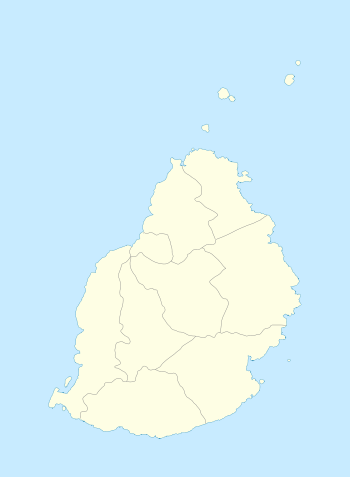Flic-en-Flac
| Flic-en-Flac | |
|---|---|
| Village | |
|
Flic-en-Flac beach | |
 Flic-en-Flac | |
| Coordinates: 20°16′47.21″S 57°21′59.23″E / 20.2797806°S 57.3664528°ECoordinates: 20°16′47.21″S 57°21′59.23″E / 20.2797806°S 57.3664528°E | |
| Country |
|
| Districts | Rivière Noire |
| Government | |
| Time zone | MUT (UTC+4) |
| Airport | SSR International Airport (distanced approximately 50 km) |
Flic-en-Flac is a seaside small town on the western part of the island of Mauritius in the district of Rivière Noire (Black River).[1][2]
The name most likely comes from an Old Dutch phrase, "Fried Landt Flaak", meaning free, flat land. Its public white sandy beach is one of the longest on the island. This public beach attracts local families and visitors during the weekends, picnics, sand sports such as football or volleyball, and swimmers.[3] Its lagoon is protected by the surrounding coral reefs.[4] The beach provides scenic views over the Indian Ocean horizon and of Le Morne Brabant Peninsula located in the south west of Mauritius. Flic-en-Flac is near Tamarin beach which is situated a few kilometres away. The Casela Bird Park near Flic-en-Flac features orchids, over 140 species of birds and the endemic and endangered rare pink pigeon.[4]
Flic-en-Flac is in a non-industrial part of Mauritius, with a coastline of about 13 kilometres (8.1 mi). It is geared towards tourism with many luxury hotels in Mauritius,[5] experiencing about 500,000 visitors yearly.[2] Spread over 10 square kilometres (3.9 sq mi) of Flic en Flac, it hosts about 4 square kilometres (1.5 sq mi) of sugarcane plantations. The town has River Rempart to its south, a La Ferme Reservoir to its northeast, and a groundwater flow which provides freshwater spring to marshes and lagoons near the town.[2]
The beach erosion and corals near Flic-en-Flac have been the subject of several studies on global climate change.[6] According to Sachooda Ragoonaden, the sea-level rise is causing a shoreline retreat of 2.7 metres (8.9 ft) per year near Flic-en-Flac.[7] The Mauritius government has built gabions to address this erosion, but the subsequent tidal damage has raised concerns about its quality and stability.[8]
The resident youth culture in Flic-en-Flac is quite similar to those found in the beach towns of neraby Reunion, Seychelles and Tamatave (Madagascar).[9]
See also
| Wikimedia Commons has media related to Flic-en-Flac. |
References
- ↑ "Flic en flac - Mauritius". travelmauritius.info. Retrieved 24 August 2012.
- 1 2 3 Minu Gupta Bhowon; Sabina Jhaumeer Laulloo; Henri Li Kam Wah; et al. (2012). Chemistry for Sustainable Development. Springer Science. p. 41. ISBN 978-90-481-8650-1.
- ↑ Reena Dobson (2007), Beaches and Breaches: Articulations and Negotiations of Identity, Ethnicity and Cosmopolitanism in Mauritius, Limina: A Journal of Historical and Cultural Studies, University of Western Sydney, page 7
- 1 2 Martine Maurel (2007). Mauritius. New Holland Publishers. pp. 88–90. ISBN 978-1-84537-647-5.
- ↑ Martin Nicholas Kunz (2005). Luxury Hotels Africa/Middle East. teNeues. pp. 98–115. ISBN 978-3-8327-9060-8.
- ↑ Risk, Michael J.; Nairn, Robert B.; Kolberg, Mark O. (2007). "Factors Influencing the Long-Term Stability of the Carbonate Sand Beaches of Mauritius". Coastal Sediments: 1708–1721. doi:10.1061/40926(239)134.
- ↑ Sachooda Ragoonaden (1997), IMPACT OF SEA-LEVEL RISE ON MAURITIUS, Journal of Coastal Research, SPECIAL ISSUE NO. 24. ISLAND STATES AT RISK: GLOBAL CLIMATE CHANGE, DEVELOPMENT AND POPULATION (Fall 1997), pp. 205-223
- ↑ C. A. Brebbia; G. Benassai; G. R. Rodríguez (2009). Coastal Processes. WIT Press. pp. 155–156. ISBN 978-1-84564-200-6.
- ↑ Pascal Duret et al (2000), Quelles identités culturelles pour les jeunes de l’Océan Indien?, Agora débats/jeunesses, Volume 20, Numéro 1, pages 13-22

.svg.png)